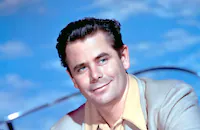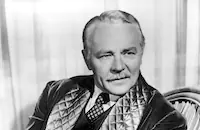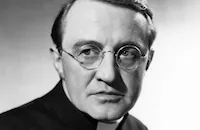Gallant Journey

Brief Synopsis
Cast & Crew
William A. Wellman
Glenn Ford
Janet Blair
Charles Ruggles
Henry Travers
Jimmy Lloyd
Film Details
Technical Specs

Synopsis
In San Diego, California, Father Dick Ball tells two young boys the story of his childhood friend and one of the city's most famous citizens, John Joseph Montgomery, who, in 1883, was the first American to fly a glider plane. The priest begins his story in 1879, when John began sharing his dreams with Regina Cleary, his sweetheart: John's family dismisses his desire to fly as mere foolishness, and when his father Zachary, an ambitious attorney hints that his son's pursuits will harm his career, John abandons his dream. Regina, however, does not believe Zachary's fears are legitimate, and urges John to continue his work in secret. John agrees with Regina, and, in August 1883, makes his first successful test flight in a contraption that he calls an "aeroplane." When Regina announces to John's family that John made his first flight, Zachary, now the Assistant Attorney General of the United States, urges his son to forget the flying machine and concentrate on his religious studies instead. With the helpful intervention of Father Ball, however, John gets support for his glider invention from Father Kenton, an aviation enthusiast, who gives John a job and provides him with a workshop at Santa Clara College. Time passes, and John, having built many models of his flying machine, looks forward to the day when he will finally be able to test a full-size. John's dream of flying is nearly lost one day when he suffers a dizzy spell and collapses. After being told by a doctor that his dizzy spells will preclude him from ever flying, John feels that he has been denied his true passion and becomes despondent. John later regains his confidence in the glider project when parachutist Dan Mahoney, who performs at carnivals under the name "Professor LaSalle," offers to test John's glider by attaching it to his hot air balloon and releasing it in mid-air. With help from Dick and Father Kenton, Dan makes a successful take-off and soars above the clouds before descending to a perfect landing. Though he later receives many letters of praise for his invention, John finds that he is broke. A short time later, Dan is killed during a test flight, and John again becomes discouraged. John's luck turns from bad to worse when a strong earthquake destroys his glider and much of Santa Clara College. The only possession John is able to salvage from the quake is his gold-panning machine, which he sells for $25,000. After marrying Regina, John is sued by a man who claims that the gold machine belonged to him and that John had no right to sell it. The lengthy trial results in a ruling in John's favor, but the expensive trial leaves him broke again. Undeterred by his misfortunes, John rebuilds his glider, and decides to fly it himself. During the flight, John suffers from another dizzy spell and loses control of the plane. The plane crashes, and John dies a few hours later.

Director

William A. Wellman
Cast

Glenn Ford

Janet Blair

Charles Ruggles

Henry Travers
Jimmy Lloyd

Charles Kemper

Arthur Shields
Willard Robertson

Selena Royle
Robert Dehaven

George Tyne
Loren Tindall
Byron Morgan
Eula Morgan
Michael Towne
Paul Marion
Henry Rowland
Robert Hoover
Paul E. Burns
Chris-pin Martin
Fernando Alvarado
Bobby Cooper
Rudy Wissler
Tommy Cook
Buddy Swan
Conrad Binyon
Crystal Reeves
Kathleen O'malley
Helene Nielsen
Frank Darien
Gil Lacava
Emory Parnell
Billy Bletcher
Robert Dudley
Joseph Palma
Lou Davis
John Kascier
Cy Shindell
Earle Hodgins
Fred Amsel
Bob Perry
Jack Frack
Hugh Hooker
Frank Dae
June Bryde
Ernie Adams
Hurley Breen
Gerry Coonan
Dan Dix
Charles Perry
Cy Malis
E. L. Dale
William Kahn
Victor Travers
Jessie Arnold
Wanda Perry
Bob Ryan
Bill Wallace
Mike Lally
Tim Wallace
Don House
Pat Moran
Stub, A Dog
Crew
Carl Anderson
Gert Anderson
Juanita L. Bell
Larry Butler
Al Clark
Louis T. Diage
Elmer Dyer
Philip Faulkner
Don Glouner
Frank Goodwin
Stephen Goossón
Burnett Guffey
Thelma Hoover
Jean Louis
Otho Lovering
Paul Mantz
George B. Meehan Jr.
William Montague
Byron Morgan
Sam Nelson
Col. C. A. Shoop
Marlin Skiles
M. W. Stoloff
William A. Wellman
William A. Wellman

Photo Collections
Videos
Movie Clip


Film Details
Technical Specs

Articles
Gallant Journey
The aviation drama Gallant Journey (1946) was a perfect project for Wellman, since aviation was the grand obsession of his life. He personally pursued it as a flyer in the French Foreign Legion, a pilot in the Lafayette Flying Corps, and an Army Air Corps flight instructor. He also probed the subject in numerous other films. Early ones include the silent Wings in 1927-winner of the first Academy Award for Best Picture-and 1930s titles like Young Eagles (1930) and Men with Wings (1938); later came projects like the fine 1953 drama Island in the Sky and the semi-autobiographical Lafayette Escadrille, which ended his career on a disappointing note in 1958.
Yet even though filmmaking and flying intertwined in every stage of Wellman's professional life, he apparently didn't regard Gallant Journey as a very important project. He doesn't discuss it in his autobiography, and most of his admirers-a club including such luminaries as Stanley Kubrick and Martin Scorsese over the years-would hesitate to rank it alongside, say, Wild Boys of the Road (1933) or The Ox-Bow Incident (1943) or the 1937 version of A Star Is Born.
Still, the movie has its charms. Wellman exemplified a kind of filmmaker that's in short supply nowadays but was common in the bygone studio era-directors who could switch from larger-than-life mythmaking to cornier-than-life kitsch in a single movie, and sometimes in a single scene, making the transition at a breakneck pace. The most famous specimens of this breed range from D.W. Griffith and John Ford to Frank Capra and, yes, Wellman, whose hard-bitten Wild Bill persona didn't prevent him from piling on the schmaltz when the spirit moved him.
Gallant Journey proves the point. Looked at one way, it's an adventure-filled biopic about an intrepid young man who becomes a flying-machine pioneer by following his dream no matter how many skeptics call him a crackpot. Looked at another way, it's a romantic comedy-drama complete with coy dialogue, bashful courtship, and a full stock of Hollywood clichés. Wellman plunges into both aspects of the story with equal energy, whipping up a confection that's contrived and sentimental but-if you can tune into its old-fashioned emotional wavelength--surprisingly tasty all the same.
The story centers on John J. Montgomery, a real-life inventor and aviator who made America's first manned and controlled heavier-than-air flights in 1883, exactly two decades before the Wright Brothers made a more enduring mark by outfitting their plane with a gas-powered engine and propeller. Using gliders for his early experiments, Montgomery was the trailblazer who proved that a cumbersome man-made machine could soar almost as high as the clouds. He died in 1911, when he lost control of a glider and crashed.
Gallant Journey begins with Montgomery as a youth, full of flying-machine dreams that seem silly to many of his nearest and dearest. They sing a different tune after he achieves his first small successes, though, and soon he expands his experiments by teaming up with a carnival performer who uses a hot-air balloon to give his plane a higher starting position. By this time Montgomery has started suffering from dizzying fits of vertigo (sorry, Jimmy Stewart, you weren't the first) that keep him earthbound while his partner has all the fun.
Montgomery's first exploits are financed on a shoestring, but his fortunes rise when he gets a profitable patent on a gold-sifting gizmo he's invented; then they plummet when he spends all the cash on lawsuits defending the patent. Another subplot focuses on his friendship with a couple of idealistic priests who give him moral support and a place to work, keeping faith in his ideas even when others waver. This part of the story is also based on fact, since the real Montgomery attended Santa Clara College, a Jesuit school, and later became a professor there.
Flying, money, vertigo, priests-what else does a movie need? A love angle, of course. Enter the winsome Regina Cleary, forever making goo-goo eyes at Montgomery no matter how distracted he is by his aeronautical challenges. She believes in him, supports him, and stands by him right to the end. And he loves her just as much, especially when she sacrifices a silken undergarment to mend a damaged glider. Regina's scenes provide most of the movie's schmaltz, especially in the bittersweet finale, which serves up enough saccharine to season a dozen ordinary pictures.
Gallant Journey tells its tale through flashbacks, as a gang of 1940s kids learn about Montgomery from a talkative codger they've met in a park. You might expect this old guy to reveal himself eventually as Montgomery grown old, or a priest grown old, or someone from the story grown old. But the film forgets about him after a while, so he doesn't get to reveal himself at all. Which is just as well, since it allows Wellman to extract every last ounce of emotionalism from the picture's dewy-eyed climax.
The most impressive element of Gallant Journey is its camerawork, which captures the exhilaration of gliding above the California countryside in grandly picturesque images. To get these, producer-director Wellman employed multiple cinematographers, and it's a pity he (or Columbia Pictures, his studio) didn't choose to shoot it in color, which could have raised a diverting movie to the level of an enchanting one.
Wellman also assembled a first-rate cast, headed by affable Glenn Ford as Montgomery and perky Janet Blair as his loyal lady love. The supporting players include twinkly-eyed Charles Ruggles as the codger in the park, Henry Travers and Arthur Shields as the helpful Jesuits, and Jimmy Lloyd as the flyboy who gives his all on Montgomery's behalf. Gallant Journey struck New York Times critic Bosley Crowther as the work of a filmmaker "quite as cuckoo as Montgomery was thought to be." But what would cinema be without crazy dreams? Hop into your imaginary glider, suspend those pesky smidgens of disbelief, and enjoy.
Producer: William A. Wellman
Director: William A. Wellman
Screenplay: Byron Morgan, William A. Wellman
Cinematography: Burnett Guffey
Aerial Photography: Elmer Dyer Film Editing: Al Clark
Art Direction: Stephen Goossón, Carl Anderson
Music: Marlin Skiles
Cast: Glenn Ford (John J. Montgomery), Janet Blair (Regina Cleary), Charlie Ruggles (man in park), Henry Travers (Thomas Logan), Jimmy Lloyd (Dan Mahoney), Charles Kemper (Father Dickie Ball), Arthur Shields (Father Kenton), Willard Robertson (Zachary Montgomery), Selena Royle (Mrs. Zachary Montgomery), Robert DeHaven (boy).
BW-86m.
by David Sterritt

Gallant Journey
Quotes
Trivia
Notes
The working title for this film was The Great Highway. John Joseph Montgomery is believed to have been the first American to build and successfully test a glider plane. As depicted in the film Montgomery's first glider flight occurred in August 1883, but his most celebrated flight took place in San Diego, California, in 1905. Although the onscreen credits claim that the film tells "the story of the first man who ever flew," Montgomery's feat was, in actuality, preceded by a number of successful glider flights in Europe, including that of Jean Marie le Bris in France in 1857, and Otto and Gustav Lilienthal's flights in Germany in the late 1800's. According to an April 1946 Hollywood Reporter news item, Columbia purchased the film rights to Montgomery's story from the San Diego Junior Chamber of Commerce, which took an active role in the film's publicity campaign and used the film to promote Montgomery's ties to San Diego.
A pre-production news item in Hollywood Reporter noted that Evelyn Keyes, who was originally set for the part played by Janet Blair, was unable to accept the role due to a scheduling conflict with The Jolson Story (see below). Screenplay co-writer Byron Morgan and his wife Eula appear in the film as a married couple. A March 1946 Hollywood Reporter news item noted that Homer Davies was assigned to "special publicity work," but his contribution to the released film has not been confirmed. While Hollywood Reporter news items indicated that actress Adeline de Walt Reynolds was set to appear in the film, her appearance in the final film has not been confirmed. Hollywood Reporter news items also note that David A. Wilkie, "one of the world's first test pilots," was contacted by director William Wellman to supply "background information" needed for the production, and that some filming took place in Malibu, Del Monte and Lasky Mesa in California. In April 1947, according to Hollywood Reporter, Byron Morgan filed a $50,000 lawsuit against Columbia, charging that the studio did not give him proper authorship credit in publicity and advertising materials. The outcome of the suit has not been determined. Glenn Ford and Janet Blair recreated their film roles for a Lux Radio Theatre broadcast on November 11, 1946.














